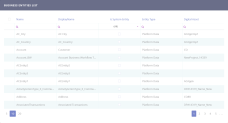Business Entities
Introduction
An entity is an object in the system that you want to model and store information about. Entities are recognizable concepts which have relevance to the database. Some specific examples of entities are: Customer, Product, Offer or Contract. An entity is similar to a table in the relational model.
Types of entities
In FintechOS, there are three types of entities:
- Platform Data - Native FintechOS data which is created and stored within FintechOS.
- External Source Data - External persistable data which is created in external systems and replicated within FintechOS. This is historical data (read-only data) which you can view in detail in analytics. External Data Source entities stores data from external systems replicated in FintechOS though Data Pipes. For more information on how to replicate data from external systems in FintechOS, see Data Pipes.
- Transient Data - Entities that temporarily store data that has been loaded from or is going to be saved to an external data source. For more information, see Transient Data Entities.
Platform Data entities encompasses:
- System entities - are used by FintechOS to run as an integrated operating system (OS). You can add Attributes on system entities, define specific forms and views, but you cannot delete them.
- ebsMetadata - stores entities' metadata. For example, information about the entities which are level 1S options on the Innovation Studio main menu.
- ebsLocalization - stores records for entitles Language and Currency Code.
- ebsAudit - stores logging information The ebsAudit schema is comprised of the EbsLogs.UniversalLog and EbsLogs.ApiLog. For more information, see the Core DPA Platform Administration Guide.
- Custom entities - are the entities you define for your application in order to accommodate various business flows. For example: 'Contract', 'Application', 'Legal Agreement'.
System entities are found in the database under the following schemas:
System entities can be used within business processes, if needed. For example, the 'systemuser' entity, which stores information of users authorized to log in the platform can be equally used in 'task management' flows for assigning users to tasks.
Custom entities will be found in the database under the ebs schema or under the schema inserted in the organization table.
Viewing existing business entities
To see the list of entities, follow these steps:
- At the top-left corner of the page, click the menu icon. The navigation menu expands.
- From the menu, click Evolutive Data Core > Data Model Explorer. The Business Entities List page appears.
The following entity details will be displayed:
| Field | Description |
|---|---|
|
Entity Type |
Choose one of the following:
|
| Name | The entity name as it is stored in the database. |
| DisplayName | The entity name displayed on views and forms. |
| Is System Entity | Indicates the entity type. If the value displayed is true, it is a system entity. |
Click column headers to order grids ascending or descending.
You can filter entities by all the search fields displayed in grid, including Name and DisplayName. You can apply multiple filtering criteria at the same time.
At the top right corner of the screen, there is a toolbar with the following buttons:
| Button | Description |
|---|---|

|
Inserts a new business entity. For details, see Creating Entities. |

|
Deletes the currently selected entities. For details, see Deleting Entities. |

|
Exports entities. For details, see Data Exports. |
|
|
Opens the Advanced Find window, allowing you to define complex filtering criteria based on the entities' attributes. For details, see Advanced Entity Find. |
